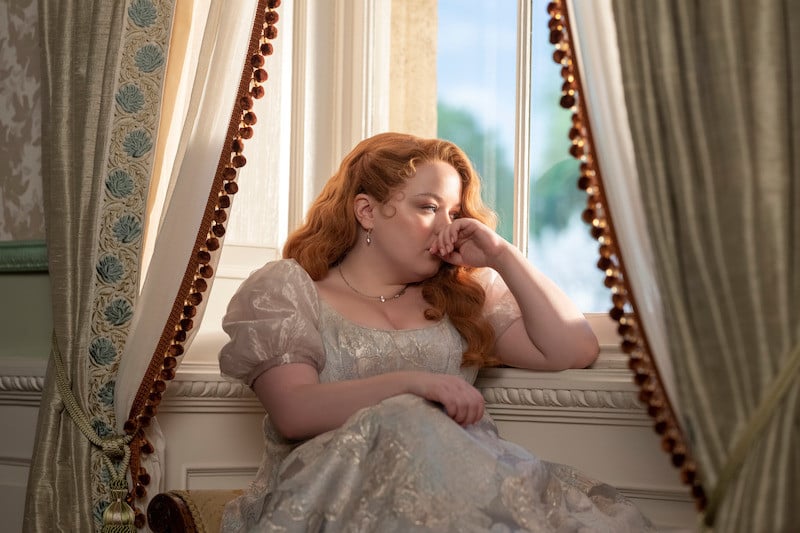Loved one, dear reader, Bridgerton is back for its third season in a world where mystery and elegance dance in the most seductive waltz and rumours of scandal float in the air like a light jasmine perfume. Another gripping story from Shonda Rhimes and her writers set against the sumptuous backdrop of Regency-era London. Four new episodes, split into two parts, are currently available for binge-watching.
Even if the show dabbled in storytelling in earlier seasons, it is in this third instalment that Bridgerton discovers its purest, most captivating tune as it proceeds to skillfully sew stories of friendship and love like a master tailor.
The third season delves further into the lives of the ensemble cast while telling the tale of Penelope Featherington (Nicola Coughlan), a woman who is determined to find a husband after becoming weary of being disregarded by her family and society. She devises a hurried plan and recruits Colin Bridgerton (Luke Newton), who has just returned from his travels and is suddenly the most eligible bachelor in the town, to advise her on finding a partner.
The two, their interactions laden with unsaid passions, negotiate the perilous waters of the adored friends-to-lovers cliché. The troubling thing is that Colin never saw Penelope as a potential love partner; instead, he saw her as a dear friend for many years. However, during the course of an episode, his heart stirred with sentiments that were either predominately old or fresh. This dramatic change, while certainly sincere, appeared almost too quick to be true. I was not moved by it in the way that I would normally be by a well-done romance.
The most interesting storyline in Bridgerton is the developing, frequently turbulent connection between Penelope and Eloise Bridgerton (Claudia Jessie), which is gently cultivated amidst the parade of corseted courtships and eager moms. Bridgerton’s actual appeal rests in its examination of non-romantic relationships, as seen by the development of what started out as a subplot into the show’s central theme.
At the end of the previous season, Eloise revealed Penelope to be Lady Whistledown, played by Julie Andrews. The expected fallout opens this season. Their bond is filled with the kind of depth that results in genuinely engaging drama. It is based on years of shared secrets and understanding. The narrative really comes alive during the intimate moments of betrayal, the heated discussions, and the heartfelt reconciliations. A sense of authenticity and relatability is there in this friendship, despite its extreme strain, which sets it apart from some of the show’s love partnerships.
Women leading the charge
This season continues Bridgerton’s tradition of treading carefully between historical romance and contemporary social critique. It serves as a mirror for society, displaying the strict social divisions of the time as well as the restricted opportunities available to women. Characters like Eloise who challenge social norms highlight how important women’s responsibilities continue to be. Claudia excels in her role as Eloise, bringing humor to the narrative with her incisive wit and one-liners.
However, Penelope ends up becoming our story’s real heroine. Her discreet career as a businessman emphasizes how women succeeded at a time when there were few role models or avenues for them to do so. Nicola’s portrayal of the dual nature of a character who is both the perceptive gossip columnist and the ignored wallflower is a masterclass in acting. What makes Penelope one of the most interesting characters in the series and Nicola one of its most gifted actors is the constant specter of Lady Whistledown in her depiction of the bashful heroine.
Symphony of style
Every season of Bridgerton is visually stunning, a genuine kaleidoscope of color, texture, and flair. It truly is a masterpiece. The production design immerses visitors in a staged world where every element, from the floral arrangements to the gilded chandeliers, is a tribute to luxury and grandeur. It is masterfully coordinated by maestros Alison Gartshoe and Phillip Corps.
Particular recognition should go to John Glaser’s costume design team because every costume is an artistic creation that conveys a great deal about the characters wearing it. In addition to enhancing the visual splendor, the vivid colors and elaborate decorations also function as a narrative technique, expressing the characters’ status, personalities, and emotional states. This season represents Penelope’s yearning for independence by deviating from her family’s normal preference for citrus tones. Penelope’s new color scheme, hairstyle, and cosmetics were carefully chosen to complement the arch of her character.
The music for the film combines modern hits by Pitbull, Taylor Swift, and Billie Eilish with classical pieces. An iconic Shonda Rhimes touch that gives the historical setting a contemporary spin to keep things interesting and current. Sadly, the classical versions of this specific set of songs fell flat. They were perfectly timed for a ballroom jive, but they were emotionally lifeless during the more private passages where the emotional resonance of the music is vital.
I am a dedicated student currently in my seventh semester, pursuing a degree in International Relations. Alongside my academic pursuits, I am actively engaged in the professional field as a content writer at the Rangeinn website.







